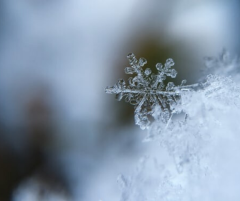How Honeybees Keep Warm in the Winter
How Honeybees Keep Warm in the Winter
Honeybees
are
an
insect
that
most
people
are
familiar
with.
They
are
associated
with
making
honey,
obviously,
and
are
usually
the
variety
of
bees
that
you
would
see
on
a
group
tour.
Most
people
know
that
without
honeybees
we
would
not
have
honey,
the
delicious
addition
to
many
of
our
favorite
foods.
But
what
happens
to
honeybees
in
the
winter?
Though
most
people
probably
don’t
even
think
about
it,
those
that
do
might
presume
that
beekeepers
have
special
houses
or
bring
them
indoors
somewhere.
Neither
of
these
presumptions
is
correct.
Even
bees
that
are
“kept”
by
beekeepers
handle
the
winter
instinctively.
They
are
an
amazing
flying
insect
and
you
should
take
a
peek
at
how
they
winter.
Bee Colonies
Bees
live
in
colonies
and
there
are
several
types
of
bees
in
each
colony.
Each
type
has
its
own
job.
The
most
important
bee
is
the
queen.
Without
the
queen,
there
would
be
no
colony
as
her
sole
purpose
is
to
lay
eggs
to
produce
more
bees.
The
other
two
types
are
drones
and
workers.
Drones
are
males.
Their
only
job
is
to
find
a
queen
to
reproduce
with.
The
worker
bees
are
female,
and
they
literally
do
all
the
rest
of
the
work,
from
foraging
for
nectar
with
which
to
make
honey,
to
tending
to
the
hive.
In
late
summer,
the
queen
starts
producing
“winter”
bees.
These
bees
have
a
4
to
6-month
life
span,
unlike
the
summer
bees
who
live
only
4
to
6
weeks.
The
winter
bees
are
also
different
physiologically
from
the
summer
bees.
When
the
summer
bees
die,
the
winter
bees
replace
them.
Sorry
to
say,
throughout
the
winter,
only
the
females
survive.
The
drones
are
no
longer
needed
as
they
would
eat
too
much.
How Do They Prepare?
Aside
from
spending
the
summer
making
enough
honey
to
feed
the
colony
itself,
they
are
also
busy
making
excess
food
to
take
them
through
the
winter.
They
don’t
sleep
for
months
like
bears;
they
are
awake,
eating,
and
trying
to
stay
warm.
To
survive,
they
must
have
a
healthy
and
productive
queen
and
a
large
and
healthy
group
of
winter
bees.
How Do They Survive?
When
the
temperature
drops
into
the
’60s,
the
bees
begin
to
cluster
together.
In
this
way
they
keep
themselves
and
most
importantly,
their
queen,
warm.
When
the
outside
temperatures
begin
to
drop
into
the
20s,
the
bees
on
the
inside
of
the
cluster
start
beating
their
wings.
This
raises
the
temperature
and
keeps
both
themselves
and
the
queen,
warm.
The
bees
on
the
outside
of
the
cluster
act
as
insulation.
As
the
temperature
of
the
hive
heats
up,
the
outer
layer
of
bees
in
the
cluster
prevents
the
warmth
from
leaving
the
hive.
As
the
outer
layer
of
bees
gets
cold,
they
trade
places
with
the
inner
layer
and
the
whole
process
begins
again.
The
temperature
at
the
inside
of
the
cluster
can
get
as
high
as
81
degrees
while
the
temperature
at
the
outside
of
the
cluster
is
about
48
degrees.
They
also
have
“heater”
bees.
These
bees
vibrate
their
abdomens
to
keep
adjacent
empty
cells
warm.
This
is
necessary
because
as
they
eat
the
food
stores
where
they
are
located,
they
eventually
must
move
to
another
cell.
The
“heater”
bees
prevent
them
from
having
to
begin
the
entire
process
again
by
keeping
the
cells
warm
when
they
are
empty.


